
Re-Entering Analog: Assembling An Analog System Featuring Pro-Ject RPM 5
Carbon turntable, Pro-Ject Debut Carbon Record Master Hi-Res turntable,
Pro-Ject Debut Carbon DC Esprit SB turntable, Parasound JC 3 Jr. Phono
preamplifier, and Okki Nokki Record Cleaning Machine MK II.
Review By Dwayne Carter
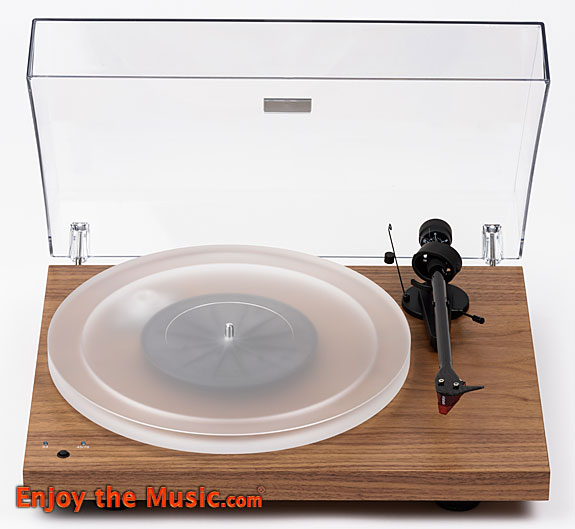
The passing of a family member is often a time of reflection and grief. With the passage of time, wounds heal, and some memories begin to fade. If you are lucky, a few remnants and reminders get passed down to you. A lifetime of possessions can be reduced to a storage shed (or two), then eventually down to a few boxes. Over this past year, of all the many boxes my brother has deposited at my front door, it was the last box he delivered that was a treasure trove. Inside the last box was 28 mostly pristine LP’s dating from the 1970s through the early 1990s.
Admittedly, my first thought was financial recycling (i.e. sell them). Audiophiles are constantly in search of a new funding stream to finance their next piece of gear. This audiophile was no different. Had I found an easier way of appraising and selling these LP’s, they would have been out the door that afternoon. That would have been a huge mistake as would have denied myself countless hours of musical enjoyment. Fortunately, my fleecing attempt didn’t make it past the first album. Reaching into the box, I happened to pull out the album Warm Breeze with Count Basie and His Orchestra [Pablo Records D2312131]. It was in mint condition, protected within a thick plastic cover. The album itself? Pressed in thick, red vinyl! I know, right?!?!
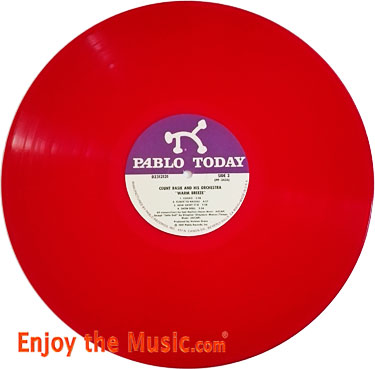
I was hooked. Sitting down on the office floor, carefully lifting each LP out of the dusty box; Christmas had arrived early. These albums weren’t going anywhere.
The Art Of Letting Go
For many months, Oracle Audio’s Origine turntable had graced the Audio Room. The review long over, my trusty old Technics
SL-D3 turntable (with a new Grado Prestige Black 1 cartridge) was now in its
place. The old Technics SL-D3 turntable is currently paired with the
(equally old) Parasound Zphono Phono Preamplifier. This was my vinyl system at
the time, so I settled in to spin son tracks. There was no way of knowing
the storage condition of these albums, so a good cleaning was first on the
menu. Even new albums get a quick wash, so these old vinyl albums were due for
a soaking. Currently, my cleaning system consisted of the Spin Clean Record Cleaner. With this system, the cleaning process is completed with a hand
drying, using lint-free cloths. Finally, a dust-off with the Audioquest
Anti-Static Record Brush, and the album is ready to face the needle.
Warm Breeze was placed on the Technics SL-D3 platter. A simple press of the “start” button, (followed by hand guiding the arm to the first track) and you are ready for the music. My Technics SL-D3 setup lacks a center weight/clamp, and admittedly, I missed the process of clamping down the album and “locking” it to the platter. For many months the daily process of playing an album on the Oracle Audio Origine turntable ended with securely clamping the LP to the platter with a record clamp. Somehow the “push and play” of the Technics SL-D3 left me feeling… unsatisfied.
Disengaging the tonearm lift, the Grado Prestige Black 1 needle gently descended onto the glowing red vinyl. The first track, “Cookie”, filled the Audio Room. Within moments, the tempo began to slow… then return to normal… then slow again. I quickly engaged the tone arm lift and removed the album. Grabbing a known “good” album, 180 gram pressing of Bruce Hornsby and The Range The Way It Is, the process was quickly duplicated. The results were the same. On the final pass, the turntable came to complete stop. My faithful Technics SL-D3 was sending me a loud message. She was done. It was time to let her go.
With A Little Help From My Friends
With the thought of adding (yet another) dead or dying component to my
electronic graveyard (i.e. my packed garage shelf); did what any budding
reviewer would do. I contacted my boss for help. With a few emails to Creative
Director Steven R. Rochlin and made my plea. I was looking for mid-level
turntable / preamplifier system, yet at an affordable price. Steven’s answer
was short and sweet. “Pro-Ject. Just contact Pro-Ject”. So, I did.
When contacting Megan (with Pro-Ject); I specified what I was looking for. An affordable turntable; that not only sounded great, but looked good as well. As with most turntables, it would be at the top of my audio rack, in full view. An eyesore would not do. Reviewing Pro-Jects vast catalog of turntable choices; three different turntables held my interest: the Pro-Ject RPM 5 Carbon (in Black), the Debut Carbon Record Master Hi-Res (in Matte Walnut), and the Debut Carbon DC Esprit SB (in bold Red). The Debut Carbon Record Master Hi-Res and the Debut Carbon DC Esprit SB were close in specifications and pricing, but I loved the look (and spec’s) of the Pro-Ject RPM 5 Carbon (in Black). In the end, I couldn’t decide which of the three turntables to review. For my sins, Pro-Ject sent all three.
Eyeing my trusty old Parasound Zphono Phono Preamplifier, I contacted Phil Jackson from Parasound. At the time, Parasound was making headlines for their JC3+ Phono Preamplifier. That sweet gem was a bit out of my price range ($2,995), but their new phono preamplifier (the Parasound JC 3 Jr. Phono Preamplifier at $1,495) was starting to gather attention as well. A few emails later, and the Parasound JC 3 Jr. Phono Preamplifier was also headed my way.
The final link in the chain, was the record cleaning process. The trusty Spin Clean Record Cleaner was fine, but it could be a bit messy. Lint free gloves and rags do a good job, but I’ve always thought a proper cleaning, ended with a strong vacuuming. Having worked with Nancy Weiner of VANA, Ltd. during my review of the Audio Physic Tempo Plus loudspeakers, I was quickly reminded of three things:
1) Nancy was awesome to work with.
2) Nancy promised me a pair of the Audio Physic Cardeas 30 loudspeakers to review.
3) Nancy had Okki Nokki cleaning products at her disposal.

OK, number one and three are true. Along with having an awesome name Okki Nokki, they manufacture this record cleaning machine. I wanted one. Nancy sent one. Life was good. In about ten days, the Audio Room was filled with boxes. Three turntables from Pro-Ject, the Parasound JC 3 Jr. phono preamplifier, and the Okki Nokki Record Cleaning Machine (RCM).
Truth be told, this tech geek has a bit of fear regarding turntable setups. My first experience setting up a ‘proper’ high-end audio turntable was the Oracle Audio’s Origine turntable. It didn’t come with any directions and it was in several pieces. It also came with white lint-free gloves, which made me even more nervous. Luckily, Pro-Ject has people like me in mind. As I had three turntables to choose from consisting of the RPM 5 Carbon, Debut Carbon Record Master Hi-Res, and Debut Carbon Esprit SB, I picked the one that appeared to be the easiest to assemble. This was Pro-Ject’s Debut Carbon DC Esprit SB.

Pro-Ject’s Debut Carbon DC Esprit SB arrived packed in a plain brown box. Basic component packing material easily held this light turntable in place during shipping. Within minutes I had the turntable out of the box and onto the setup table. The Debut Carbon DC Esprit SB was painted in stunning, bright red as requested. As the Audio Room is finished in muted tones of dark tan and browns, the bright red turntable resting on atop of the rack was a welcome departure. With manual in hand my initial setup began.
The Debut Carbon DC Esprit SB is an upgraded version of the Debut Carbon DC, with an acrylic platter and 33.3 / 45 RPM button on the left side of the plinth. To a novice vinyl guy, a full-sized, easy to read manual, is most welcomed. Pro-Ject has put together a simple manual; that takes you from un-boxing to spinning the vinyl, in just eight short pages. A manual is becoming a rare sight these days. I get it. They can be a waste of paper and other resources. A CD or DVD would waste even more.
Most manufacturers assume you have an internet connection, so they direct you to their website. Once there, you will be able to simply download a copy of the manual. In most cases, this is true. In many cases, it is not. How many of you out there have wasted precious time, looking for that &*^H@U# manual on-line?? I know I have. Many manufacturers need to take a basic course in web design. Three clicks. It should take just three clicks. If you can’t find what you need in three clicks, then the website gets a fail… but I digress.
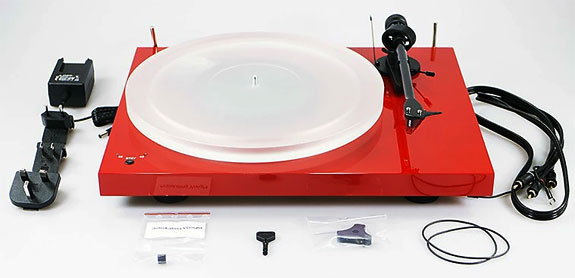
Pro-Ject is having none of that! Cappuccino in one hand, and the manual in the other. Pro-Ject’s Debut Carbon DC Esprit SB was set up in 17 minutes (yes, I had to put the cappuccino down from time to time). It took me a few minutes to figure out how to assemble and mount the counter-weight, but other than that I was setup in 17 minutes! The counter-weight / anti-skate setup delayed me a bit.
Unfortunately, eyesight becomes an issue with age and the Debut Carbon DC Esprit SB as well as the other turntables requires one to loop a hair-thick wire to the rear of the tonearm as a part of the anti-skating force-adjustment. Once that challenge is mastered, then your assembly is complete. All that remains, is spending a few minutes with your standard calibration and tracking tools, (our free Enjoy the Music.com alignment tool will work). I was now ready to calibrate. My choice for calibration LP was The Ultimate Analogue Test LP [Analogue Productions 200 gram].
Connections from the Pro-Ject Debut Carbon DC Esprit SB turntable, to the Parasound JC 3 Jr. Phono Pre-amp were completed with the included RCA cables (initially), as they had an attached ground wire. Eventually, this cable was replaced with a pair of Audioquest Big Sir RCA cables (to the phono pre-amp, with a separate ground wire). The Audioquest Mackenzie (XLR) balanced cables fed the signal to the balancing inputs on the Audio Research LS27 preamplifier (coming from the Parasound JC 3 Jr. outputs).
Both the Pro-Ject Debut Carbon DC Esprit SB turntable and the Debut Carbon Record Master Hi-Res turntable come with the (much reviewed) Ortofon 2M Red phono cartridge (already pre-mounted). The pre-mounted cartridge shortened the setup time considerably. I had spent several months with the Ortofon 2M Blue phono cartridge mounted on the Oracle Audio’s Origine turntable, so I assumed the sound characteristic and specifications would be familiar to me. They did. More on this, later. With the turntable ready to play; the Parasound JC 3 Jr. Phono Preamplifier was next out of the box. In typical Parasound fashion, the JC 3 Jr. Phono Preamplifier was safely packed in dense Styrofoam, and wrapped in a thick plastic cover. Resting nicely on top was a paper manual. Perfect!
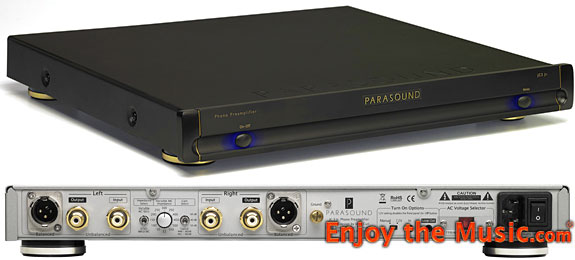
Parasound’s JC 3 Jr. Phono Preamplifier is much larger and heavier than my old Parasound Zphono Phono Preamplifier. While half the size of her big brother JC3+, the Parasound JC 3 Jr. is an impressive 17″ x 14″ x 2.5″ box. Weight is a hefty 13 pounds! I didn’t open it up, yet know it is packed with aluminum partitions and a steel encased power transformer. It’s much heavier than it looks.
The Parasound JC 3 Jr. Phono Preamplifier (your choice of silver or black) features a thick milled aluminum face, with a small power button located on the far-left side. The button is backlit with a pale blue led, which casts a faint glow (in a darkened room). The light glows a bit brighter when on, but I found myself turning it off and on, to determine what state the pre-amplifier was in. Is it On or Off? Like my Bryston amp and Wadia DAC, (eventually), I kept the Parasound JC 3 Jr. turned on, for the duration of the review. The only other button on front? A rare, mono button.
Parasound’s JC 3 Jr. phono preamplifier has considerably more going on in the rear than my old Parasound Zphono: Vampire 24k gold-plated RCA Input / Output connections, Neutrik balanced XLR jacks, Gain toggle switch (40, 50, or 60 dB for the unbalanced inputs, and 46, 56, and 66 dB for the balanced), MM or MC toggle switch, Variable MC Impedance knob (50 to 550 Ohms), 12V trigger input/output loop, voltage selector, turn on options, and main power switch. Once set for my turntables at 47kOhm MM @ 40dB gain and cables connected, I rarely looked upon the rear of the Parasound preamp again. The total time from unboxing all components to a washed LP clamped on the platter: 81 minutes. Starting where the Technics SL-D3 stopped, Warm Breeze would be the first musical album to play.
The Pro-Ject Debut Carbon DC Esprit SB turntable is simple to use. To the lower left of the platter, you will find a small, black Speed/Power button. To select 33.3 rpm, press once. To select 45 rpm, press twice. To power down, press and hold for a few seconds. Once powered, a dim blue led will glow. This light will blink, when you select a speed change. Their carbon fiber tonearm is manually controlled, as you simply unlock the tonearm from the tonearm rest lock, pull back in the arm lift lever (to raise the tonearm) and guide the arm over the moving platter. Push forward on the arm lift lever to slowly allow the needle to land on the selected track.
The first track “Cookie” blared out of the Martin Logan’s! Springing from my chair, I dialed the volume down quickly. This was unexpected. With my old Parasound Zphono Phono Preamplifier in the loop, the volume selection on my Audio Research LS27 preamplifier was always between 37 and 40. I initially set it at 40. It was now at 28, and yet still too loud for comfort. This was an unexpected (and welcomed) surprise. The Parasound JC 3 Jr. Phono Preamplifier has got some serious output gain. So noted.
Settling in again, I enjoyed the remainder of the first side of “Warm Breeze”. Critical listening would have to wait out the break-in period, but initial notes were brief and to the point. “Clean, but overly bright” were the only notes for the morning. Obviously, breaking in a turntable system requires some patience. At around 30 minutes of music on a side, there would be no “press play and walk away”. Since the Pro-Ject Debut Carbon DC Esprit SB turntable and the Debut Carbon Record Master Hi-Res turntable were sonically the same; I concluded the brightness was probably coming from the Parasound JC 3 Jr. Phono Preamplifier. It was going to take several break-in sessions to tame this beast. I was looking forward to it.
Putting on my longest playing album, Beth Hart’s 37 Days, I unboxed the Pro-Ject Debut Carbon Record Master Hi-Res turntable and took it into the office. While the Office system is not on par with the Audio Room; it’s no boom box either. With a rack-mounted Bryston 3B ST amplifier, Apple iMac (with external DAC), an old Bryston 1B pre-amp, and Jamo Concert 8 speakers; this office system can rock!
The Pro-Ject Debut Carbon Record Master Hi-Res turntable would spend the next few months, connected to the iMac, as a recording source. For sound comparison with the Debut Carbon DC Esprit SB turntable, I would (later) bring it back to the Audio Room. Once all the parts were un-wrapped, it took a mere 14 minutes to setup this turntable. The Pro-Ject Debut Carbon Record Master Hi-Res turntable that was sent for review, was virtually identical to the Pro-Ject Debut Carbon DC Esprit SB turntable (now playing within the Audio Room).
Except for the nostalgic wood grain finish, both turntables looked identical. From the front, side and top; the Debut Carbon Record Master Hi-Res turntable and the Pro-Ject Debut Carbon DC Esprit SB turntable looked the same. Same acrylic platter. Same carbon arm. Even the same cartridge (the Ortofon 2M Red phono cartridge). The only difference was on the back.
On the back of the Debut Carbon Record Master Hi-Res turntable, you find some additional input / outputs. On the right rear in addition to your standard RCA Line Output and ground / earth connector you will find S/PDIF Out, USB Out, and Phono/Line In input, Phono/Line In Selector and Record Level knob. The power connection, like the Debut Carbon DC Esprit SB turntable is located on the rear/middle as well.

The Debut Carbon Record Master Hi-Res turntable came packaged identically to the Debut Carbon DC Esprit SB turntable; except for one small item. A CD-ROM loaded with USB drivers and the VinylStudio Lite software. Once powered up, I connected the USB cable from the turntable to my Apple iMac. The Mac didn’t need any drivers loaded (Windows drivers are supplied on the CD-ROM), and instantly recognized the turntable. The VinylStudio Lite software installed without any issues, and immediately notified me of an update. Total setup time from unboxing to recording my first LP (included software update and reboot) was 33 minutes.
While larger than a laptop, the Pro-Ject Debut Carbon Record Master Hi-Res turntable looked right at home, next to the rest of my office gear. With just a few miss-starts and do-overs, a full LP recording was on my NAS (in DSD quad rate: DSD256 at sample rate of 705.6kHz) within the hour. The VinylStudio Lite software is relatively easy to use, and has pop-up help screens, every step of the way.
Virtually all the adjustments are made, using the software interface. About the only physical adjustment you need to make on the turntable, would be to adjust the Record Level knob (located on the back of the turntable). The Record Level knob is used to adjust the analogue signal going into the A/D converter. The first task during a recording session is to set the input level in the software. You want it just below clipping (just a few red peaks are fine by me). Admittedly, this task is a bit touchy. With the knob located behind the turntable, it can be a bit tricky to adjust properly. I bumped the needle a few times, before reaching the correct recording level.
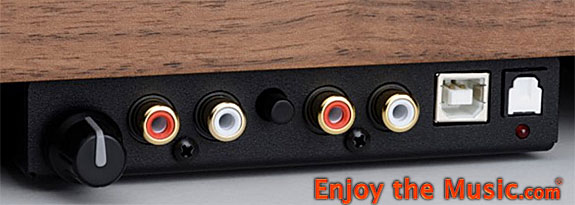
Once your recording levels are set, just click record. The software has a noise threshold (adjustable) and will “listen” for the music to start. You are now recording the album! As the Turntable was resting on the same surface as the iMac, I was careful not to cause any skips. Adding four isotonic isolation discs gave me a little breathing room from surface noise. While your album is recording, you can get to work downloading album art, and looking up track names (album metadata); all within the app.
By the time one side is recorded, you have all the metadata selected and ready to add to the “files”. Once the entire album is recorded, you then select the location of the file(s), choose the format and click “Save”. All done. Just want to record a few tracks? Same process. Done. The VinylStudio Lite software is surprisingly easy to use. The (included) Lite version is very powerful. During the “Save” process, you can burn the files direct to CD, save them into a mobile device friendly or streaming device format, and more. The software will record your favorite album or track in Pulse-code modulation (PCM) or Direct Stream Digital (DSD) over PCM (DoP). What resolutions you may ask? Well, let me tell you: PCM at 16 / 24 / 32-bits at 44.1 / 48 / 88.2 / 96 / 192 / 384 kHz. Direct Stream Digital (DSD) over PCM (DoP) at DSD standard rate: DSD64 at sample rate 176.4kHz, DSD double rate: DSD128 at sample rate 352.8kHz and DSD quad rate: DSD256 at sample rate 705.6kHz. Formats include AIFF, DSD, DFF, FLAC, MP3 and OGG.
All these choices are included, with the free version of the software. For $29.95 you get additional editing functionality (filter out tape hiss, hum and rumble, software RIAA equalization and more). I wouldn’t mind filtering out some hisses and pops. $30 to add even more functionality to this software is a small price to pay. I won’t get into the merits of recording an old mono track at DSD256. It’s nice to know you can!
For most of my recordings I chose the FLAC format. It’s the default format for most of my high-resolution files. I spent the next few days recording mostly tracks (not entire albums). There are many soundtracks and long forgotten 12″ singles in my collection. I rekindled many fond memories with the Pro-Ject Debut Carbon Record Master Hi-Res turntable and VinylStudio Lite software combo. As I stare at the poor condition of some of my vinyl, I wonder about my mental state (back in the 1980s). Either they were poorly or incorrectly stored, trashed with a bad needle, or all the above. Luckily, I had the Okki Nokki Record Cleaning Machine.

The Okki Nokki Record Cleaning Machine MK II is simplicity personified. It is a black or white unit measuring 13″ x 16″ x 13″, with a quiet motor to spin the platter forward and reverse. It has a strong vacuum motor inside and movable vacuum tube on top. The unit comes with concentrated cleaning fluid and a goat hair scrubbing brush. Assembly takes just 10 minutes. While my Spin Clean Record Cleaner did a great job of soaking my albums, I always felt like I was just pushing the grime around. No matter how careful; cleaning liquid would splash over the surrounding area. Not so with the Okki Nokki Record Cleaning Machine. It has a strong vacuum. Maybe too strong? Let me explain.
The cleaning process is simple. Place your dirty album on the platter. Tighten the album to the platter with the (included) aluminum record clamp. Turn on the motor (forward or reverse). Apply the record cleaning solution to the surface. Scrub with the goat hair brush. Click the switch to turn the platter in to the opposite direction. Scrub a bit more. Click the motor to forward, then turn on the vacuum (all buttons located on the front). Swivel the vacuum tube over and down to the album surface. Vacuum until the excess solution has been sucked away. It works well… maybe too well.
On several occasions, the suction was so strong, that the album stopped spinning. The simple solution was to re-tighten the record clamp. This usually worked.
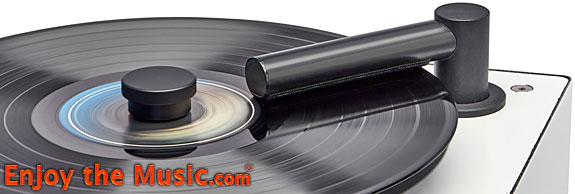
Early in the review process, I over-tightened the aluminum record clamp, and stripped the threads. A quick email to Nancy, and another clamp was on its way. I would like to say the new clamp solved this issue… but it did not, completely. The suction was just too strong! That’s not a bad thing (and a problem every vacuum product should have). My solution? A trip to Home Depot. I made a “record clamp” out of a nut and large washers. It’s not pretty, but I can crank that baby down tight! Problem solved. I will continue to look for a production record clamp that will work as well. Until then, I’ll just keep my ugly Home Depot solution hidden from public view.
Other than the minor clamp issue, the Okki Nokki Record Cleaning Machine is an awesome product. I’m not going to tell you, that the Okki Nokki Record Cleaning Machine will remove years of vinyl abuse. It won’t. A deep scratch is a deep scratch. The Okki Nokki Record Cleaning Machine will clean the grit and grime from within the groves of that deep scratch. It will do it very well! During my review, every record was cleaned with the Okki Nokki Record Cleaning Machine, before it was played. Every record. No exceptions! A record cleaner of some type should be the second item on your vinyl system shopping list. It’s about as sexy as a UPS; but like a UPS, you won’t miss it until it’s too late.
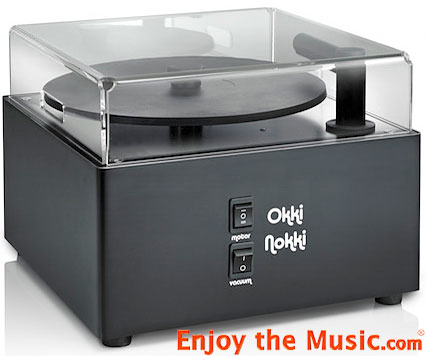
The third turntable I saved for last. The Pro-Ject RPM 5 Carbon box had been sitting in the corner of the Audio Room for a few weeks at this point. It was time to man up. Unlike the Pro-Ject Debut Carbon Record Master Hi-Res turntable and the Pro-Ject Debut Carbon Record Master Hi-Res turntable; the Pro-Ject RPM 5 Carbon was one of their higher-end turntables, with a free-standing synchronous motor. Free-standing, as in not attached. As in separate. That meant, the turntable was going to be in separate pieces. This concerned me.
Earlier, I admitted to having a bit of trepidation, over the setup and calibration of turntables. My first encounter with a high-end turntable (with a free-standing motor), was the Origine turntable. It did not come with a manual (originally). The Pro-Ject RPM 5 Carbon did, which is good.
It took me a bit longer to assemble the RPM 5 Carbon, than with the other two turntables. As with the Debut Carbon Record Master Hi-Res turntable and the Debut Carbon Esprit SB; the manual was a great help. With the last two steps remaining (placing the free-standing motor the correct distance from the platter and installing the belt); Pro-Ject was one step ahead of me. Included with the Pro-Ject RPM 5 Carbon was a Belt Hook and Motor/Platter Template. The Motor/Platter Template was a simple piece of plastic that you loop over the top of the motor and rest up against the platter. Your motor is now the correct distance from the platter. Using the Belt Hook, simply loop the belt around the hook, while turning the platter. Done! With the included tools, this was a simple task. Again, kudo’s Pro-Ject!
The outboard synchronous AC motor drives the belt (that is now turning the platter). You switch from 33.3 rpm to 45 rpm by moving the belt to the top of the pulley. A flick of the simple on/off switch at the top of the motor, and you are ready to play music.
Assembly complete; I stopped to take a good look. The Pro-Ject RPM 5 Carbon is a striking turntable. My review unit was graphite black, (but the RPM 5 Carbon is also available in white and red). The gloss black plinth and the EVO tonearm (made from carbon fiber) appeared to be forged from a single piece. The tonearm comes pre-mounted with the Sumiko Blue Point No. 2 moving coil phono cartridge. The acoustically inert acrylic platter, which is featured on all three review models, appeared even more striking against the cool looking black plinth surface. Allowing for a few minutes of vanity, I re-attached a set of small LED lights to the back of the phono stand. The small LED lights added a nice glow, through the acrylic platter.
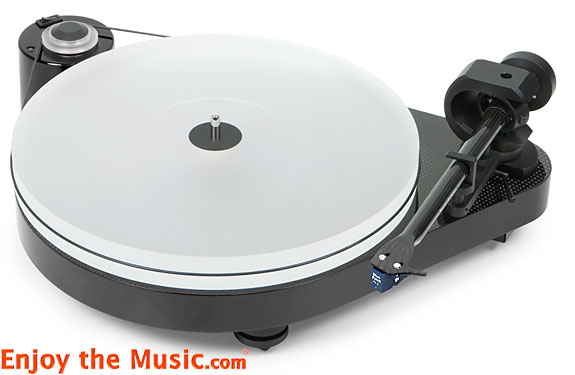
The LED lights lends nothing to the sound, but everything to the experience. In case you are wondering, the small LED lights are plugged into their own UPS/Surge protector (on a separate circuit from the rest of the audio gear), as they are known to produce a faint hum when on. I originally used this little LED light setup, with the Origine turntable. With the RPM 5 Carbon fully assembled and lit, it was time for more music!
Most of my record collection is from the 80’s and was abused in the most horrible ways you can imagine. CD’s were new and cool, so my LP’s were tossed (literally) to the side. I started rebuilding my vinyl collection during Christmas 2017. Rebuilding from scratch takes time (and a chunk of money). Last year, I started with Beth Hart’s 37 Days, for my wife, and Bruce Hornsby and The Range The Way It Is for me [APRV 30118 and AEXH 44072 respectively]. Both were 180 gram pressings. I have now amassed over fifteen, newly pressed, heavy-gram LPs.
Purchased for my wife, one of my new favorite LP’s, is a previously unreleased album, by Prince. Many of his recordings are finally becoming available, and a few are receiving the high-resolution or heavy-vinyl treatment. The latest favorites, Prince: Piano & A Microphone [1983 Deluxe Limited Edition 180 gram LP & CD WEALP85882] and Queen: Made In Heaven [half-speed mastered 180 gram dual LP HRLP32900] were going to be next vinyl on the platter. The only issue was, which one, on which turntable? I had three to choose from?
Pro-Ject turntables were designed from the ground up, to be an affordable analog force to be reckoned with. While price doesn’t always correlate into quality, I decided to start with the Pro-Ject Debut Carbon DC Esprit SB turntable ($599), followed by the Pro-Ject Debut Carbon Record Master Hi-Res turntable ($850), and finishing with the Pro-Ject RPM 5 Carbon ($1,499). Queen: Made In Heaven would start the show.
Spinin’ Wax
Fresh off the Okki Nokki Record Cleaning Machine MK II, I lifted the dust
cover on the striking red Debut Carbon DC Esprit SB turntable and clamped
down Queen Made In Heaven. This was my latest purchase and I was
eager to put it through the review process. This release was Half-Speed
Mastered (under the supervision of Bob Ludwig) and the lacquers were from
Abbey Road Studios. You need to look very hard, to find a pressing with more
pedigree. “It’s A Beautiful day”, “Made In Heaven” and “Let Me Live” flowed
easily through the room. I didn’t stop for a break, until the end of side two
(“Heaven For Everyone” was the final track). It may be a little on the nose,
but I felt like a little piece of heaven was in the Audio Room. I had grown so
accustomed to the sound of my old Technics SL-D3 / Zphono combo. It was fine.
A bit mushy and muted. A bit dull. I knew my LP’s should sound better, yet was
daunted by the task of putting together a better sounding rig.
As mentioned before, I was accustomed to the Ortofon “sound”. I auditioned the Ortofon 2M Blue on the Oracle Audio’s Origine turntable. Listening to the Ortofon 2M Red cartridge on (both), the Pro-Ject Debut Carbon DC Esprit SB turntable and the Pro-Ject Debut Carbon Record Master Hi-Res turntable, I arrived at the same conclusion. The Ortofon 2M line, is a better than average entry-level cartridge (although the 2M Red is about half the price of the 2M Blue). The 2M Red cartridge has an above average dynamic range, (for an entry-level cartridge), which is why it is so popular with manufacturers, in the below $1000 turntable market.
As I tend to be long-winded, let me summarize my consistent listening notes, of the Pro-Ject Debut Carbon DC Esprit SB turntable, Pro-Ject Debut Carbon Record Master Hi-Res turntable and the Parasound JC 3 Jr. Phono Preamplifier. Solid, very strong midrange, with bass (both mid and low) were solid as well. I wanted more. Mid to high range was strong as well, yet without the “tinkle at the top-end” desired. I was able to hear every cymbal crash that was played, but didn’t feel the cymbals within the room. What I did hear was a vastly improved musical soundstage from my old rig. This was a solid performance for two entry-level turntables. Pro-Ject has hit it on the marks with performance and pricing.
I Wanted More
When assembling a turntable system (as with any system), you should strive for
balance. Both in sound quality and price. As I’ve said, price doesn’t always
correlate with (sound) quality. The combination of the Debut Carbon DC Esprit
SB turntable (and the Debut Carbon Record Master Hi-Res turntable) with
the Parasound JC 3 Jr. Phono Preamplifier, yielded very good
results. But I wanted more. While the two turntables would fall into the
entry-level field at $499 and $599 respectively, the Parasound JC 3 Jr. Phono
Preamplifier is $ 1,499. A bit outside of entry-level for me, so I needed to
push the phono preamp more. Enter, the Pro-Ject RPM 5 Carbon turntable
($1,500).

The Pro-Ject RPM 5 Carbon turntable comes with the Sumiko Blue Point No. 2 moving coil phono cartridge. This high(er) output (2.5-mV), alloy cantilever, Blue Point-cut elliptical diamond stylus cartridge, proved to be a welcomed surprise. This time, starting with the piano-heavy Prince: Piano & A Microphone LP; I again had to jump on the volume knob. Recomposed, I started again. Instantly noticeable, was the increase in brightness and clarity, on the top-end. The mid to upper highs were more pronounced. Over time, this brightness tamed a bit but in a positive way. This new setup was more balanced. The lows blended with the highs. The mids with the lows. It was a fuller, more even soundscape than previously.
The Prince album, Prince: Piano & A Microphone, is actual excerpts from studio sessions, recorded in 1983 (at Prince’s Kiowa Trail home studio in Chanhassen, MN). The album concept itself, takes me back to my happy times as a studio rat. I still have some of my old studio “rambling” sessions (on cassette tape). Listening to them now; is both exhilarating and painful. As I listened to this album; I was instantly transported back to that crowded basement studio, in Fort Atkinson, WI (egg carton-lined walls and all).
Side A is one long melody (“17 Days / Purple Rain / A Case of You / Mary Don’t You Weep / Strange Relationship / International Lover / Wednesday”). Prince plays the piano, alone in the studio. Other than requesting a few board changes from the engineer, it’s just an artist and his piano. While I enjoyed the performance, with the Debut Carbon Esprit SB/Debut Carbon Record Master Hi-Res turntable; the RPM 5 Carbon turntable (with the Sumiko Blue Point No. 2 cartridge) gave me the sense of “being there”. I was sitting in the corner of Prince’s studio. This combination paired with the Parasound JC 3 Jr. remained in place until the end of my review period.
Other than my initial description, I have not singled out the excellent performance of the Parasound JC 3 Jr. Phono Preamplifier. This is both telling and purposeful. The Parasound JC 3 Jr. Phono Preamplifier pulls off one of the most difficult jobs in business. It remains silent and unnoticeable. Only when it is absent, do you know how much it was doing for you and your system.
The Parasound JC 3 Jr. Phono Preamplifier is the Secret Service of your audio system. Once you have it setup for your cartridge, you will rarely touch it. It will just sit there in your rack, hour after hour, day after day, cartridge upgrade after upgrade. Remove it from your system, and you will immediately miss the clear tonality and sonic imaging it was providing. As the John Curl designed little brother to the JC3+, I would have expected nothing less. The best preamplifiers disappear into the background. The Parasound JC 3 Jr. Phono Preamplifier is one of them and at $1,495 it is a real-world bargain!
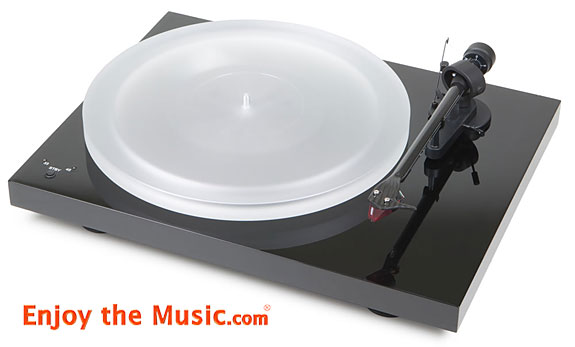
Decisions, Decisions, Decisions
My old Technics SL-D3 turntable was destined for the garage shelf. She was
done. Before me, I had three replacements. The Pro-Ject Debut Carbon DC Esprit
SB turntable was a solid choice. As a bonus, my wife was crazy about the
Ferrari red color. So was I. The Debut Carbon Record Master Hi-Res turntable
was also a solid performer and provided me with an easy to use recording
interface. I wanted that, too. Sonically, the Pro-Ject RPM 5 Carbon
turntable was a few notches above the other two, so parting with this
turntable was not a pleasant thought. I couldn’t keep all three of them, could
I?
No. No I couldn’t.
Pro-Ject knows what they are doing. They consistently release great sounding, well-built, affordable turntables (and supporting electronics). I was staring at three of them. I was also staring at the Parasound JC 3 Jr. Phono Preamplifier, underneath my old Parasound Zphono Phono Preamplifier (for photo purposes). I wanted that, as well. My old Parasound Zphono Phono Preamplifier is not even in the same league. Not even close. If I wanted to continue playing and enjoying my now-growing album collection, the Okki Nokki Record Cleaning Machine was staying too.
With my bank account in mind, the Pro-Ject RPM 5 Carbon turntable would be the winner. If I can scramble a few more coins together, the Debut Carbon Record Master Hi-Res turntable will be returning to my office rack. It would give me piece of mind knowing I could digitize any of my vinyl collection relatively easily. I was more than ready to retire the Zphono Phono Preamplifier or pass it on to a vinyl newbie, with the JC 3 Jr. Phono Preamplifier taking its place. The Okki Nokki Record Cleaning Machine needed a spot as well, so I’m looking to add another Salamander rack to the Audio Room. My analog upgrade was now complete.
I wonder what my brother is dropping off next?
Review Equipment
Digital Sources: Apple iMac (2.7GHz Intel Core i5, 8GB RAM, 1TB SSD),
Apple MacBook Pro (2.66GHz Intel Core 2 Duo, 8GB RAM, 512GB SSD) running OS
10.11.5, Audirvana Plus Software, iTunes 12, VLC, Synology DS516+ NAS
Server, OPPO BDP-103 universal BD player, OPPO BDP-205 UDP BD
player, Apple iPad Pro & iPhone 6, Questyle QP1R DAP.
Analog Sources: Technics SL-D3 Automatic Turntable
Digital Processors: Wadia Di322 DAC, Audioquest DragonFly Red DAC
Pre-Amp: Audio Research LS27
Phono Pre-Amp: Parasound Zphono
Power Amplifiers: Bryston 4B SST2, Bryston 3B ST.
AV Receivers: Denon AVR-X4300H, Integra DRX-5
Loudspeakers: Martin Logan Summit, Martin Logan Purity, Jamo Concert 8, Sonus Faber Chameleon B, M&K V1250THX Subwoofer, SVS Ultra-13 Subwoofer.
Headphones: OPPO PM-1(Balanced), Meze 99 Classics, Noble Audio K10 CIEM, Noble Audio Django IEM.
Accessories: Dedicated 20A lines to dual Furman Elite ELITE-20 PF I surge protectors.
| Tonality |
    
|
| Sub–bass (10Hz – 60Hz) |
   
|
| Mid–bass (80Hz – 200Hz) |
   
|
| Midrange (200Hz – 3,000Hz) |
    
|
| High Frequencies (3,000Hz On Up) |
   
|
| Attack |
   
|
| Decay |
   
|
| Inner Resolution |
   
|
| Soundscape Width Front |
    
|
| Soundscape Width Rear |
   
|
| Soundscape Depth Behind Speakers |
   
|
| Soundscape Extension Into Room |
   
|
| Imaging |
    
|
| Fit And Finish |
    
|
| Self Noise |
    
|
| Value For The Money |
    
|
Specifications
Project RPM 5 Carbon Turntable
Precision belt drive using free-standing synchronous motor
Ultra-precision DC-driven AC generator motor power
Inverted platter bearing with ceramic ball
Acoustical inert acrylic platter
9″ cc EVO tonearm made from carbon
Counterweight with TPE damping
Adjustable aluminum tip-toe feet
Available with or without Ortofon Quintet red cartridge
Three high-gloss colors (black, red, white)
Lid available as an option
Technical Specifications:
Speed 33, 45 (manual speed change)
Drive principle Belt drive
Platter 300 mm acrylic
Mains bearing Stainless steel axle with ceramic ball
Speed drift 33.3: +/- 0.12% I 45: +/- 0.10%
Wow & flutter 33: +/- 0.17% I 45: +/- 0.08%
Signal to noise 73dB
Tonearm 9″ CC EVO carbon
Effective arm length 230 mm
Effective arm mass 8 g
Overhang 18 mm
Tracking force 0 – 25 mN
Included accessories 15 volts DC / 500 mA power supply
Power connection 110/240 Volt – 50 or 60 Hz
Power consumption 5 watt max / < 0,5 watt standby
Dimensions 430 x 150 x 323 mm (WxHxD)
Weight 18 lbs.
Price: $1,500
| Tonality |
    
|
| Sub–bass (10Hz – 60Hz) |
   
|
| Mid–bass (80Hz – 200Hz) |
   
|
| Midrange (200Hz – 3,000Hz) |
   
|
| High Frequencies (3,000Hz On Up) |      |
| Attack |
    
|
| Decay |
    
|
| Inner Resolution |
    
|
| Soundscape Width Front |
    
|
| Soundscape Width Rear |
   
|
| Soundscape Depth Behind Speakers |
   
|
| Soundscape Extension Into Room |
    
|
| Imaging |
   
|
| Fit And Finish |
    
|
| Self Noise |
    
|
| Value For The Money |
    
|
Project Debut Carbon DC Esprit SB (DC)
33.3/45 and 78rpm
Built-in precision Speed Box with switch on upper side
8.6″ carbon tonearm
Heavy non-resonant acrylic platter
New DC power supply with synchronous AC motor
New TPE motor suspension
Magnetic cartridge 2M red from Ortofon
For 78 playback: remove stylus & exchange to 2M78 (not included, retail
price around € 80)
High-gloss black, red or white piano lacquer finish
Dust cover included
Technical Specifications:
Speed 33, 45 / 78 (electronic/manual speed change)
Drive principle belt drive
Platter 300mm acrylic platter
Mains bearing stainless steel
Wow & flutter +/- 0.19%
Speed drift +/- 0.60%
Signal to noise 68dB
Tonearm 8.6″, Carbon
Effective arm length 218.5 mm
Effective arm mass 6.0 g
Overhang 18.5mm
Tracking force 10 – 30mN
Included accessories 15 volts DC / 1,6A power supply, dust cover
Power connection 110/120 or 230/240 Volt – 50 or 60 Hz
Dimensions 415 x 118 x 320mm (WxHxD) lid closed
Weight 12 lbs.
| Tonality |
   
|
| Sub–bass (10Hz – 60Hz) |
   
|
| Mid–bass (80Hz – 200Hz) |
   
|
| Midrange (200Hz – 3,000Hz) |
   
|
| High Frequencies (3,000Hz On Up) |
   
|
| Attack |
   
|
| Decay |
   
|
| Inner Resolution |
   
|
| Soundscape Width Front |
   
|
| Soundscape Width Rear |
   
|
| Soundscape Depth Behind Speakers |
   
|
| Soundscape Extension Into Room |
   
|
| Imaging |
   
|
| Fit And Finish |
   
|
| Self Noise |
   
|
| Value For The Money |
   
|
Project Debut Carbon RecordMaster HiRes
Precision belt drive with decoupled synchronous motor
Heavy non-resonant acrylic platter
Built in MM phono preamplifier
Line output and USB out for audio recording in PCM 24-bit/192kHz or DSD256
11.2MHz
Simultaneously connection with amplifier & PC/Mac
2M Red moving-magnet cartridge fitted
Available in three high-gloss finishes (piano, red or white) and walnut
matt
Dustcover included
Speed 33.3, 45 / 78 (electronic/manual speed change)
Drive principle belt drive
Platter 300mm acrylic platter
Mains bearing stainless-steel axle in a bronze bearing housing
Wow & flutter 33.3: ±0.19% 45: ±0.17%
Speed drift 33: ±0.6% 45: ±0.7%
Tonearm 8.6″ Carbon
Effective arm length 218.5 mm
Overhang 18.5mm
Tracking force 10 – 30mN
A/D Converter Asahi Kasai Microdevices, AK5552VN
Sampling frequency up to 192kHz
Output Line (RCA), S/PDIF optical & USB-B (USB 2.0)
Input Line In (RCA)
Included accessories 15 volts DC power supply, dust cover
Power connection 110/120 or 230/240 Volt – 50 or 60 Hz
Dimensions 415 x 118 x 320mm (WxHxD)
Weight 12 lbs.
| Tonality |     |
| Sub–bass (10Hz – 60Hz) |     |
| Mid–bass (80Hz – 200Hz) |     |
| Midrange (200Hz – 3,000Hz) |     |
| High Frequencies (3,000Hz On Up) |     |
| Attack |     |
| Decay |     |
| Inner Resolution |     |
| Soundscape Width Front |     |
| Soundscape Width Rear |     |
| Soundscape Depth Behind Speakers |     |
| Soundscape Extension Into Room |     |
| Imaging |     |
| Fit And Finish |     |
| Self Noise |     |
| Value For The Money |     |
Parasound JC 3 Jr. Phono Preamplifier (Halo – by John Curl)
Circuitry designed by John Curl
Circuit board layout by Carl Thompson
Cartridge options for 47k Ohm MM and MC
Variable MC impedance adjustment of 50 to 550 Ohms
Gain select for 40, 50, and 60 dB unbalanced (46, 56, and 66 dB balanced)
Balanced and unbalanced outputs
Mono switch can improve sound of mono & older LPs
Convenient auto turn-on by 12V trigger
RIAA accurate to within 0.2dB
Incredible S/N up to 94dB and THD less than 0.02%
Vishay-Dale resistors in the audio path
Aluminum shield separates power supply and audio circuits
Shielded toroid power transformer
High speed-soft recovery bridge rectifiers and common mode inductors
Vampire brand 24k gold-plated RCA jacks
Neutrik brand locking balanced XLR outputs connectors
Compact 1U chassis (2.5″ high with feet)
Available in silver or black
Technical Specifications:
20-20Khz, +/- 0.2dB Total Harmonic Distortion
MM or MI: 47kOhm
MC Variable: 50- 550 Ohm Output Impedance
Unbalanced: < 100 Ohm
Balanced: < 100 Ohm per leg Input Capacitance
150 pF Input Sensitivity at 1 kHz, 4mV Input
115 VAC or 230 VAC 50 – 60 Hz Dimensions
Dimensions: 17.25″ x 14.75″ x 2.5″ (WxDxH)
Weight Net: 13 lbs.
Price: $1,495
| Tonality |      |
| Sub–bass (10Hz – 60Hz) |     |
| Mid–bass (80Hz – 200Hz) |     |
| Midrange (200Hz – 3,000Hz) |      |
| High Frequencies (3,000Hz On Up) |     |
| Attack |      |
| Decay |     |
| Inner Resolution |     |
| Soundscape Width Front |     |
| Soundscape Width Rear |     |
| Soundscape Depth Behind Speakers |     |
| Soundscape Extension Into Room |     |
| Imaging |      |
| Fit And Finish |      |
| Self Noise |      |
| Value For The Money |      |
Okki Nokki Record Cleaning Machine MKII (RCM)
Built-in safety features prevents overheating.
Quiet vacuum motor.
Cool running turntable motor allows for hours of use.
Comes complete with record cleaning fluid and goat hair brush.
Forward and reverse motor for ‘scrubbing’ action.
Dimensions: 13″ x 16″ x 13″
Vacuum tubes for 10″ and 7″ records available.
Price $599
| Fit And Finish |     |
| Self Noise |     |
| Value For The Money |     |
Company Information
Pro-Ject Audio Systems
c/o Sumiko Audio
2431 Fifth Street
Berkeley, CA 94710
Website: www.Pro-JectUSA.com
Parasound Products, Inc.
2250 McKinnon Avenue
San Francisco, CA 94124














Want to join discussion?
Feel free to contribute!